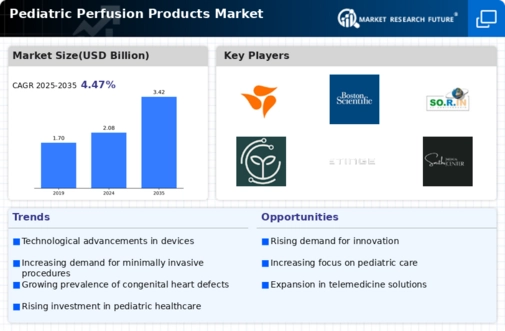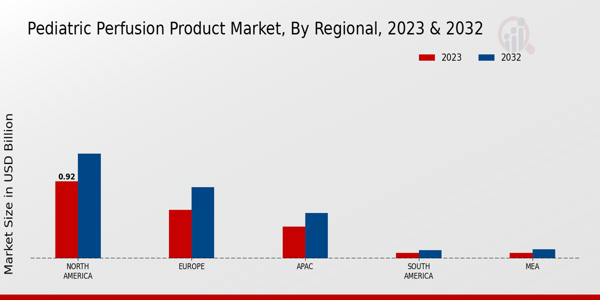Increasing Pediatric Cardiac Surgeries
The rising incidence of congenital heart defects among children is a primary driver for the Pediatric Perfusion Products Market. Statistics indicate that approximately 1 in 100 children are born with a congenital heart defect, necessitating surgical interventions. As the number of pediatric cardiac surgeries continues to grow, the demand for specialized perfusion products, such as oxygenators and blood pumps, is expected to rise correspondingly. This trend underscores the critical need for advanced perfusion technologies that can cater to the unique physiological requirements of pediatric patients. Furthermore, the increasing complexity of surgical procedures necessitates the use of sophisticated perfusion equipment, thereby propelling the market forward. The Pediatric Perfusion Products Market is likely to witness substantial growth as healthcare providers seek to enhance surgical outcomes and improve the quality of care for young patients.
Rising Awareness of Pediatric Health Issues
There is a growing awareness regarding pediatric health issues, which is contributing to the expansion of the Pediatric Perfusion Products Market. Parents and healthcare professionals are increasingly recognizing the importance of specialized care for children, particularly in the context of surgical interventions. This heightened awareness is leading to greater demand for advanced perfusion products that cater specifically to the needs of pediatric patients. Market Research Future indicates that educational initiatives and advocacy programs aimed at improving pediatric health are gaining traction, further driving the need for effective perfusion solutions. As awareness continues to rise, healthcare providers are likely to seek out innovative perfusion technologies that can enhance surgical outcomes and ensure the safety of young patients. This trend is expected to bolster the Pediatric Perfusion Products Market as stakeholders prioritize the health and well-being of children.
Technological Innovations in Perfusion Equipment
Technological advancements play a pivotal role in shaping the Pediatric Perfusion Products Market. Innovations such as miniaturized perfusion devices and enhanced monitoring systems are revolutionizing the way pediatric surgeries are conducted. These advancements not only improve the efficiency of perfusion processes but also enhance patient safety and outcomes. For instance, the introduction of advanced blood management systems has been shown to reduce the risk of complications during surgeries. Market data suggests that the adoption of these innovative technologies is on the rise, with a projected increase in market share for companies that prioritize research and development. As healthcare facilities increasingly invest in state-of-the-art perfusion equipment, the Pediatric Perfusion Products Market is poised for significant expansion, driven by the demand for cutting-edge solutions that address the unique challenges of pediatric care.
Regulatory Emphasis on Pediatric Safety Standards
The Pediatric Perfusion Products Market is significantly influenced by the stringent regulatory environment surrounding pediatric healthcare. Regulatory bodies are increasingly focusing on establishing safety standards specifically tailored for pediatric patients, which has led to the development of more reliable and effective perfusion products. Compliance with these regulations not only ensures the safety of young patients but also enhances the credibility of manufacturers within the market. As a result, companies are compelled to invest in quality assurance and product testing to meet these regulatory requirements. This emphasis on safety is likely to drive innovation and improve the overall quality of perfusion products available in the market. Consequently, the Pediatric Perfusion Products Market is expected to grow as manufacturers align their offerings with regulatory expectations, thereby fostering trust among healthcare providers and patients alike.
Customization and Personalization of Perfusion Solutions
The trend towards customization and personalization in healthcare is becoming increasingly relevant in the Pediatric Perfusion Products Market. As healthcare providers recognize that pediatric patients have unique physiological characteristics, there is a growing demand for tailored perfusion solutions that meet individual patient needs. This shift towards personalized medicine is prompting manufacturers to develop customizable perfusion products, such as adjustable blood flow systems and age-specific oxygenators. Market data suggests that the ability to offer personalized solutions is becoming a competitive advantage for companies operating in this space. As healthcare systems strive to provide more individualized care, the Pediatric Perfusion Products Market is likely to experience growth driven by the demand for products that can be adapted to the specific requirements of young patients.


















Leave a Comment